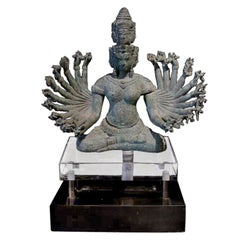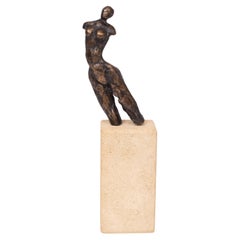Fj Hakimian Kilim
Vintage 1940s Persian Kilim Persian Rugs
Wool, Hemp
People Also Browsed
Antique 18th Century and Earlier Cambodian Sculptures
Bronze
1990s Dutch Modern Natural Specimens
Bronze
Antique 19th Century French Neoclassical Wall Lights and Sconces
Bronze
20th Century German Neoclassical Revival Table Lamps
Late 20th Century English Sculptures
Bronze
Antique Early 17th Century Chinese Ming Sculptures and Carvings
Bronze
20th Century Tibetan Sculptures and Carvings
Bronze
Late 20th Century Austrian Modern Figurative Sculptures
Bronze
Antique Late 19th Century French Neoclassical Table Lamps
Marble, Ormolu
Antique Late 19th Century French Louis Philippe Animal Sculptures
Marble, Bronze
21st Century and Contemporary Contemporary Figurative Sculptures
Bronze
Antique 19th Century Italian Neoclassical Busts
Wood
Vintage 1980s Asian Modern Figurative Sculptures
Bronze
Antique 19th Century Burmese More Asian Art, Objects and Furniture
Bronze
Vintage 1920s American Art Deco Figurative Sculptures
Bronze
Mid-20th Century European Vases
Ceramic
A Close Look at kilim Furniture
Known for their wealth of rich colors and unique weaving tradition, antique and vintage kilim rugs are one of the most distinguishable types of rugs. The term “kilim” is Turkish in origin, but many variations of this type of textile share a common heritage and are practiced all across the Balkans, throughout the Arab world and elsewhere. There are Persian kilim rugs, kilim rugs from Central Asia and more.
It is difficult to definitively pin down the origins of kilim weaving, which is known as a “flatweave” or “slit-weave,” but historians believe that skilled artisans may have practiced versions of it as early as the eighth and ninth centuries A.D. in the Anatolia region of Turkey. Many of the Turkish iterations of these flat-woven rugs are recognizable for their arrangements of dazzling, flowing forms, but a range of motifs can appear in kilim rugs — abstract figures that reference rams’ horns, snakes or running water or motifs that are intended to symbolize concepts such as the tree of life or fertility. In Anatolia, women have used kilims to share narratives about their lives.
The difference between a kilim rug and most other kinds of carpets or pile rugs is in the aforementioned weave. They are made by interweaving variously colored, individual strands of wool (pure soft cotton, silk and goat’s hair are also used with the wool, albeit rarely) versus, say, the Tabriz rugs of Iran, which are hand-knotted rugs. This results in a smooth, frequently reversible surface. It’s a slit-weave because of the gap left between two blocks of color. Kilims are created on a loom, a typically uncomplicated structure mostly made of wood. Owing to the creative freedom that a slit-weave can afford its weaver, they tend to feature a range of bright, contrasting hues like reds, oranges and pinks that appear in bold combinations with deep blues and greens that are brought to life with natural dyes.
Handwoven kilim rugs are less expensive to produce and more durable than other rugs. They were traditionally used as floor coverings in mosques and yurts, as prayer rugs and saddle coverings. And these textiles are pileless: Whereas the Beni Ourain rugs of Morocco can be described as dense with a thick surface or pile, an authentic kilim rug is thin and flat. Because the resulting weave is lightweight, kilim rugs are well adapted for use in the hot summer months, and they are happily embraced by tribal weavers of Morocco, a part of the world that is home to many styles of rugs.
With their striking geometric patterns and provocative color pairings, kilim rugs and wall tapestries are loved by design enthusiasts and can bring charm and interest into any dining room, living room or other interior space.
Find kilim rugs and textiles and other vintage rugs on 1stDibs.
Finding the Right persian-rugs for You
Make a bold statement in a living room or bedroom by incorporating vintage Persian rugs in your home decor.
A Persian carpet lends an aura of prestige to any room, even today. The fascination with Persian rugs dates at least as far back as the 4th century B.C., when historian Xenophon referred to the “soft rugs on which the Persians sit.” For centuries, Iran (modern-day Persia) has been known for the craftsmanship, intricate patterns and artistry of its carpets, which have found their way into households and museums around the world.
Although they have many imitators, real Persian rugs are made only in Iran and are easily recognized by their vibrant colors and elegant patterns.
Traditional, or antique, Persian rugs are what most people identify as “authentic.” Hand-made, they are very durable and, if properly cared for, can be passed down from generation to generation. Modern Persians, on the other hand, are often machine-made. Today’s carpets, Iranian or otherwise, can’t possibly match the level of craftsmanship that prevailed centuries ago, so historical Persian carpets will always be admired and highly valued.
Although the machine-aided production process is much faster and cheaper, the resulting rugs typically do not have the same quality or lifespan as handwoven ones, so traditional options are considered better investments.
To distinguish between the two, look for imperfections. Because traditional Persian rugs are handwoven, you will likely see small flaws on the front and back. With a machine-made imitation, on the other hand, you will probably not find stitching glitches, and the back will have a mesh or plastic covering.
Antique rugs are handmade from the finest materials, including wool, silk or cotton — never synthetic fibers. The fibers used in antique rugs are colored using natural dyes derived from insects and plants and woven into bold designs that reflect Iran’s culture and history. Since Persian tribes traditionally raised and herded sheep, wool was the most common material. The fiber has many advantages: It is fire-resistant and dries much more quickly than cotton. Also, because of its natural elasticity, it is more durable than cotton or silk. Regarded as works of art, Persian rugs can take months or years to complete.
The different types of Persian rugs are named for the cities, villages and regions where they’re made. Kashan rugs, for example, woven in the north-central Iranian city of Kashan, are considered among the finest city rugs, distinguished by curvilinear motifs like palmettos, leaves and arabesques. Nains have high knot counts, an indication of high quality, and generally employ pink, blue and ivory hues, while Tabriz rugs — created by weavers in the northwestern Iranian city of Tabrīz (or Tabriz) — mostly have floral and garden patterns.
When shopping for vintage Persian rugs, you'll want to consider color, size and more — for a history of these rugs and tips on how to style yours, visit our guide to these woven creations today.
Find Tabriz rugs, handmade silk Persian rugs, Persian tribal rugs and other antique and vintage rugs from the world's best furniture dealers on 1stDibs.


